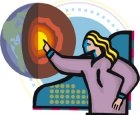
Worksheets and No Prep Teaching Resources
Reading Comprehension Worksheets
Earth Science

Earth Science
 Worksheets and No Prep Teaching Resources Reading Comprehension Worksheets Earth Science |
 Earth Science |
| edHelper's suggested reading level: | grades 9 to 10 | |
| Flesch-Kincaid grade level: | 9.36 |
|
Earth Time - The Mesozoic and Cenozoic Eras
By Trista L. Pollard |

|
 1 If you traveled back in time to the end of the Paleozoic Era, you might be a little disappointed. You would have found very few life-forms on the planet. Mass extinction occurred at the end of the Permian Period. As a result, about 90 percent of the marine animals and about 78 percent of the land animals became extinct. For the few species that survived, such as amphibians and reptiles, there were a lot of resources and space. Time for new organisms to appear!
1 If you traveled back in time to the end of the Paleozoic Era, you might be a little disappointed. You would have found very few life-forms on the planet. Mass extinction occurred at the end of the Permian Period. As a result, about 90 percent of the marine animals and about 78 percent of the land animals became extinct. For the few species that survived, such as amphibians and reptiles, there were a lot of resources and space. Time for new organisms to appear! |
Create Weekly Reading Books
Prepare for an entire week at once! |
| Leave your feedback on Earth Time - The Mesozoic and Cenozoic Eras (use this link if you found an error in the story) |
 |
Earth Science
|
 |
High School Reading Comprehensions and High School Reading Lessons
|